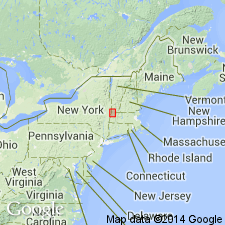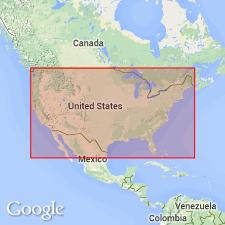
- Usage in publication:
-
- Rowe schist*
- Modifications:
-
- Age modified
- Areal extent
- AAPG geologic province:
-
- New England province
Summary:
Geographically extended into Vermont from Massachusetts. Age changed to Early Cambrian(?) because authors, who have studied and mapped the formation, consider it to be [Early] Cambrian or older.
Source: GNU records (USGS DDS-6; Reston GNULEX); US geologic names lexicon (USGS Bull. 896, p. 1849-1850).

- Usage in publication:
-
- Rowe schist*
- Modifications:
-
- Areal extent
- AAPG geologic province:
-
- New England province
Summary:
Geographically extended to NY in Rensselaer Co. from western MA.
Source: GNU records (USGS DDS-6; Reston GNULEX).

- Usage in publication:
-
- Rowe Schist*
- Modifications:
-
- Revised
- Age modified
- AAPG geologic province:
-
- New England province
Summary:
Rowe Schist revised in northwestern MA to include all strata between top of Hoosac Schist and bottom of Moretown Formation. Mapping has shown that amphibolite mapped by Emerson (1898) as one continuous unit is actually a series of beds distributed over a considerable stratigraphic interval; similar strata occur above and below Emerson's Chester Amphibolite, making upper contact of Rowe tenuous and usefulness of Chester as a formation doubtful. In addition, mapping has shown that upper part of Savoy Schist of MA is equivalent to Moretown Formation of VT; lower part of Savoy correlates with Stowe and Ottauquechee Formations in VT. This new mapping allows revision of Rowe Schist to include all of Emerson's original Rowe plus his Chester Amphibolite, and lower schistose part of his Savoy Schist. It also includes MA equivalents of Pinney Hollow Formation and its Chester Amphibolite Member, and Ottauquechee and Stowe Formations of VT. Chester Amphibolite Member is retained as a member of Rowe but only for proven continuations of amphibolite from VT to its type locality in Chester, MA. Includes rocks ranging in age from Early to Late Cambrian and possibly Early Ordovician. [Fig. 5 shows definite range into Early Ordovician.]
Source: GNU records (USGS DDS-6; Reston GNULEX).

- Usage in publication:
-
- Rowe Schist*
- Modifications:
-
- Overview
- AAPG geologic province:
-
- New England province
Summary:
Used as Rowe Schist of Cambrian and Early Ordovician age. Includes Chester Amphibolite Member within one of its two informal subdivisions.
Source: GNU records (USGS DDS-6; Reston GNULEX).

- Usage in publication:
-
- Rowe Schist*
- Modifications:
-
- Overview
- AAPG geologic province:
-
- New England province
Summary:
Used as Rowe Schist; age is Cambrian or Early Ordovician or both. [No explanation given for age change or extension from MA to CT.]
Source: GNU records (USGS DDS-6; Reston GNULEX).

- Usage in publication:
-
- Rowe Schist*
- Modifications:
-
- Revised
- Areal extent
- Age modified
- AAPG geologic province:
-
- New England province
Summary:
Included in Rowe-Hawley zone, which is defined as lithologic interval between western margin of Rowe Schist and eastern edge of principal outcrop of belt of Hawley and Cobble Mountain Formations, a western boundary of Bronson Hill zone. Rowe is divided into three unnamed members. Predominant member consists of light-green, nonrusty-weathering, fine-grained muscovite-quartz-chlorite schist containing garnet and magnetite; to the south, as metamorphic grade increases, color changes to very light green or silvery gray and staurolite and kyanite become important constituents. A second schistose member is distinctly gray rather than green, somewhat rusty weathering, and consists primarily of quartz, muscovite, biotite, and plagioclase, with accessory carbonaceous material, with thin layers of quartzite. Third member consists of black to dark-green, well-foliated, locally well-layered hornblende-plagioclase amphibolite. Authors retain redefinition of Rowe Schist given in Hatch and others (1966). However, subsequent mapping suggested modification of original mapping by Chidester and others (1967) in northern MA of Rowe Schist-Hoosac Formation contact. Intervals of light-green quartz-muscovite-chlorite schist containing abundant albite porphyroblasts occur near boundary between Rowe and Hoosac. Although light-green color and general appearance are compatible with main member of Rowe, albite porphyroblasts are characteristic not of Rowe, but of Hoosac. Remapping in North Adams quad showed large areas of albite-rich, light-green aluminous schist complexly interlayered with other members of Hoosac; relationship is probably stratigraphic. Presence of green metapelitic rocks throughout much of Hoosac and widespread occurrence of albite porphyroblasts so characteristic of rest of Hoosac have persuaded authors that green, albite-rich schist is stratigraphically related to Hoosac rather than to Rowe. Therefore, definition of Rowe is revised to exclude green, albite-porphyroblastic rocks. State bedrock geologic map of Zen and others (1983) reflects this revision. Age of Rowe is still based on correlation with strata continuous with Rowe into VT (Pinney Hollow, Ottauquechee, and Stowe Formations of Doll and others, 1961), and on the assumption that succession of formations eastward from Precambrian rocks of Green Mountain and Berkshire massifs is a true, eastward-younging sequence. Assumption about eastward-younging may not be valid due to revised thinking on structure of region. Despite uncertainties, age of Rowe is probably only slightly, if at all, older than earliest Cambrian and almost certainly no younger than Early or possibly Middle Ordovician. [Papers presented as chapters in U.S. Geological Survey Professional Paper 1366 are intended as explanations and (or) revisions to MA State bedrock geologic map of Zen and others (1983) at scale of 1:250,000.]
Source: GNU records (USGS DDS-6; Reston GNULEX).

- Usage in publication:
-
- Rowe Schist*
- Modifications:
-
- Overview
- AAPG geologic province:
-
- New England province
Summary:
Serpentinized ultramafic rock follows strike of Cambrian and (or) Ordovician Rowe Schist (Rodgers, 1985; mapped as Hartland Formation by Martin, 1970, and as Slashers Ledges Formation by Stanley, 1964).
Source: GNU records (USGS DDS-6; Reston GNULEX).

- Usage in publication:
-
- Rowe Schist*
- Modifications:
-
- Revised
- Areal extent
- Age modified
- AAPG geologic province:
-
- New England province
Summary:
Cover rocks east of and above Hoosac Formation were mapped by Doll and others (1961, State bedrock geologic map) as an eastward-topping section consisting of Pinney Hollow, Ottauquechee, and Stowe Formations. In adjacent MA, Hatch and others (1966) and Chidester and others (1967) were unable to map sequence because of both lateral and vertical variation of rock types in the belt. They chose not to use the VT nomenclature and applied the name Rowe Schist for all rocks between top of Hoosac and first beds of Moretown Formation. Pinney Hollow, Ottauquechee, and Stowe are not used in this report area because of heterogeneous discontinuous nature of those formations in this belt and uncertainty of correlation of the formations to their type sections 50 to 100 km to the north. Rowe Schist is used instead. Age of Rowe is uncertain. Although it could be Ordovician (Stanley and Hatch, 1988), it is regarded only as Cambrian in this report.
Source: GNU records (USGS DDS-6; Reston GNULEX).
For more information, please contact Nancy Stamm, Geologic Names Committee Secretary.
Asterisk (*) indicates published by U.S. Geological Survey authors.
"No current usage" (†) implies that a name has been abandoned or has fallen into disuse. Former usage and, if known, replacement name given in parentheses ( ).
Slash (/) indicates name conflicts with nomenclatural guidelines (CSN, 1933; ACSN, 1961, 1970; NACSN, 1983, 2005, 2021). May be explained within brackets ([ ]).

